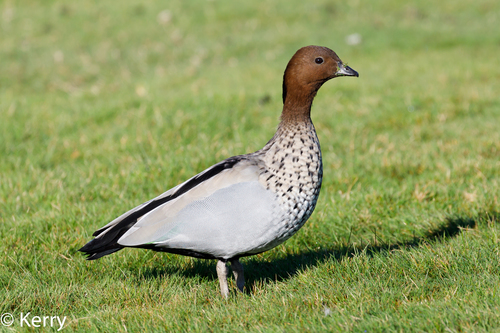
Maned Duck
The Maned Duck (Chenonetta jubata), also known as the Australian Wood Duck, is a unique dabbling duck found throughout much of Australia. It is known for its distinctive 'mane' of longer feathers on the nape of the neck, present in both males and females, though more prominent in males. This species plays a role in seed dispersal and grazing, contributing to the health of grassland and wetland ecosystems. Unlike many ducks, it spends a significant amount of time grazing on land.
44-56 cm
Length
78-90 cm
Wingspan
Least Concern
Conservation Status
Distribution
Widespread across Australia, including Tasmania, and less common in arid regions. Introduced populations exist in New Zealand, but their status is unclear. Prefers regions with scattered trees near water bodies.
Lifespan
Up to 10 years in the wild, possibly longer in captivity. Not Evaluated
Maned Duck's Habitat
Habitat Types
Grasslands, Woodlands, Wetlands, Coastal areas, Farm dams and pastures
Climate Zones
Temperate, Subtropical, Mediterranean
Adaptations
While capable of swimming, the Maned Duck is well-adapted to terrestrial life. Its relatively long legs allow for efficient walking and grazing on land. They can be found near water bodies, but do not require large expanses of open water like some other duck species.
Variations
No recognized subspecies.
Appearance
Breeding Plumage
There is minimal difference between breeding and non-breeding plumage.
Seasonal Feather Changes
No significant seasonal variations.
Sex Based Plumage Differences
Males have a dark brown head and a mottled grey body, with a distinctive black 'mane'. Females have a paler, mottled brown and grey body with white stripes above and below the eye and a less prominent mane.
Notable Features
Distinctive 'mane' of feathers on the nape (more prominent in males)., Grey bill., Dark brown eyes., Pinkish-grey legs and feet.
Diet and Feeding
Primary Foods
Grasses, Clover, Herbs, Seeds, Insects (especially during breeding season)
Foraging Behavior
Primarily grazes on land, similar to geese, by plucking grasses and other vegetation. Also dabbles in shallow water, feeding on aquatic plants and invertebrates.
Specializations
No highly specialized feeding adaptations. They are generalist herbivores, capable of adapting to various food sources within their preferred habitats.
Seasonal Diet Variations
Diet may shift slightly depending on food availability. Insects become more important during the breeding season to provide protein for egg-laying and chick growth.
Behavior
Social Structure
Forms pairs or small flocks, particularly outside the breeding season. Larger aggregations may occur at favorable feeding sites.
Communication
Males have a distinctive, drawn-out, nasal 'gnow' call., Females have a higher-pitched, quacking call., Visual displays, such as head-bobbing, are used during courtship and territorial defense.
Migration
Generally sedentary, but may undertake local movements in response to water and food availability. Not a long-distance migrant.
Territorial or Group Behaviors
Pairs defend nesting territories during the breeding season. Outside of breeding, they are generally not strongly territorial.
Conservation
Threats
Habitat loss (due to land clearing for agriculture and urbanization), Predation (by introduced predators such as foxes and cats), Overgrazing (competition with livestock), Climate change (altered rainfall patterns affecting breeding)
Protection Programs
Habitat restoration and protection initiatives in some areas., General wildlife conservation efforts that benefit wetland and woodland habitats.
Local National Laws
Protected under state and territory wildlife legislation in Australia.
Population Trend
Stable
Population Estimates
Global population estimated to be in the hundreds of thousands. Not Evaluated
Interesting Facts
They are often seen perching in trees.
Unlike most ducks, Maned Ducks are comfortable perching on branches, a behavior more commonly associated with geese.
Ducklings jump from the nest hollow to the ground soon after hatching.
This can be a considerable drop, but the ducklings are lightweight and fluffy, minimizing injury.
The name "Maned Duck" refers to the dark feathers along the back of its neck.
This is a feature common in both male and female ducks, but is more prominent in males.
Faqs about Maned Duck
Are Maned Ducks good to eat?
While they are legal to hunt in some parts of Australia during designated seasons, they are not widely considered a prime game bird due to their relatively small size and sometimes strong flavor.
Do Maned Ducks make good pets?
No, Maned Ducks are wild birds and are not suitable as pets. They require specialized care and large spaces, and it is illegal to keep them without appropriate permits.
Where is the best place to see Maned Ducks?
They are commonly seen in parks, wetlands, and farmland throughout much of Australia, particularly in areas with scattered trees near water.
How can I tell the difference between a male and female Maned Duck?
Males have a dark brown head and a more prominent 'mane,' while females have a paler, mottled brown head with white stripes above and below the eye.
Copyright @ Nature Style Limited. All Rights Reserved.
 English
English